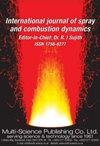基于g方程的技术预混火焰对等效比扰动响应解析模型
IF 2.1
4区 工程技术
Q3 ENGINEERING, MECHANICAL
International Journal of Spray and Combustion Dynamics
Pub Date : 2018-06-01
DOI:10.1177/1756827717740776
引用次数: 6
摘要
提出了一个技术预混火焰对当量比扰动的响应模型。该公式是基于线性化G方程的分析火焰跟踪模型的扩展,考虑了火焰脉冲对局部、脉冲、无穷小扰动的响应,该扰动通过对流从火焰底部向火焰表面传输。结果表明,层流火焰速度和反应热对脉冲响应的贡献表现出局部行为,即火焰在当量比扰动到达火焰表面的时刻和位置做出响应。这一过程的时滞与对流时间尺度有关,对流时间尺度对应于燃料从火焰底部到火焰表面的对流传输。相反,火焰表面积的贡献表现出非局部行为:尽管火焰形状的波动是由于火焰速度和流速之间的运动平衡失真而局部产生的,但火焰形状中产生的褶皱随后通过对流以恢复时间尺度向火焰尖端传输。通过比较均匀和抛物线径向轮廓的脉冲响应,证明了当量比扰动中的径向不均匀性对火焰脉冲响应的影响。观察到火焰传递函数的相位有相当大的偏差,这对热声稳定性很重要。本文章由计算机程序翻译,如有差异,请以英文原文为准。
An analytical model based on the G-equation for the response of technically premixed flames to perturbations of equivalence ratio
A model for the response of technically premixed flames to equivalence ratio perturbations is proposed. The formulation, which is an extension of an analytical flame tracking model based on the linearized G-equation, considers the flame impulse response to a local, impulsive, infinitesimal perturbation that is transported by convection from the flame base towards the flame surface. It is shown that the contributions of laminar flame speed and heat of reaction to the impulse response exhibit a local behavior, i.e. the flame responds at the moment when and at the location where the equivalence ratio perturbation reaches the flame surface. The time lag of this process is related to a convective time scale, which corresponds to the convective transport of fuel from the base of the flame to the flame surface. On the contrary, the flame surface area contribution exhibits a non-local behavior: albeit fluctuations of the flame shape are generated locally due to a distortion of the kinematic balance between flame speed and the flow velocity, the resulting wrinkles in flame shape are then transported by convection towards the flame tip with the restorative time scale. The impact of radial non-uniformity in equivalence ratio perturbations on the flame impulse response is demonstrated by comparing the impulse responses for uniform and parabolic radial profiles. Considerable deviation in the phase of the flame transfer function, which is important for thermo-acoustic stability, is observed.
求助全文
通过发布文献求助,成功后即可免费获取论文全文。
去求助
来源期刊

International Journal of Spray and Combustion Dynamics
THERMODYNAMICS-ENGINEERING, MECHANICAL
CiteScore
2.20
自引率
12.50%
发文量
21
审稿时长
>12 weeks
期刊介绍:
International Journal of Spray and Combustion Dynamics is a peer-reviewed open access journal on fundamental and applied research in combustion and spray dynamics. Fundamental topics include advances in understanding unsteady combustion, combustion instability and noise, flame-acoustic interaction and its active and passive control, duct acoustics...
 求助内容:
求助内容: 应助结果提醒方式:
应助结果提醒方式:


